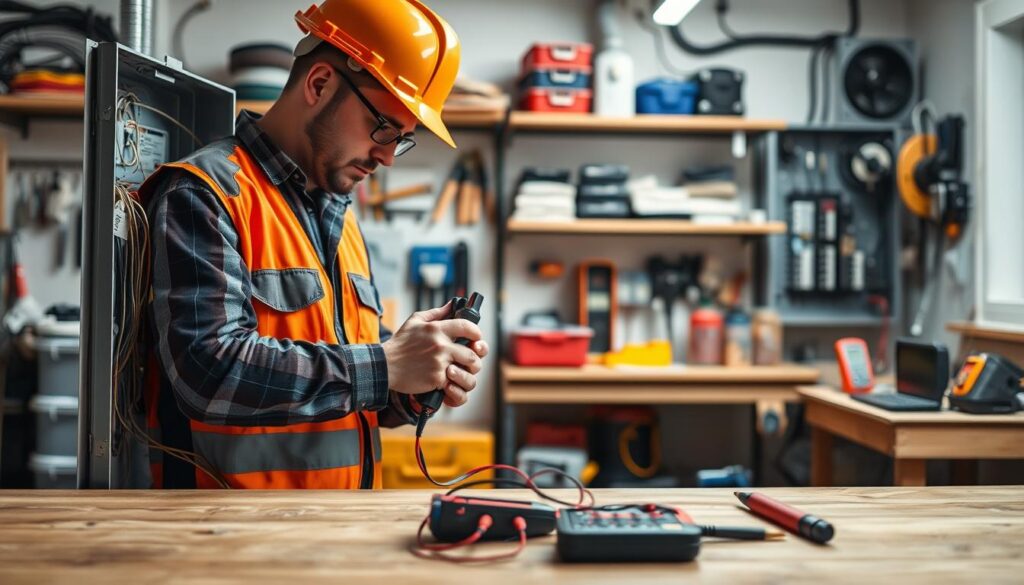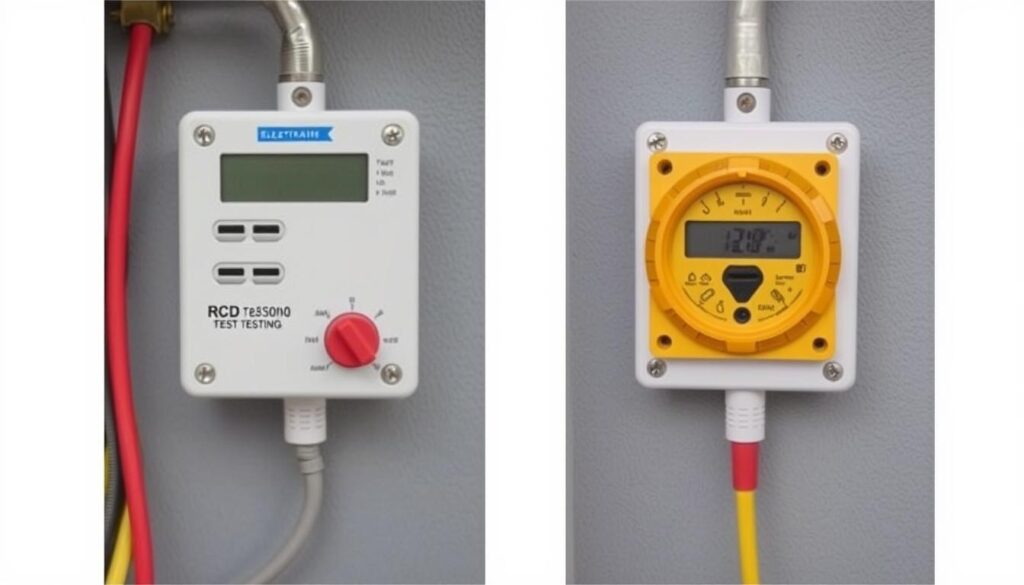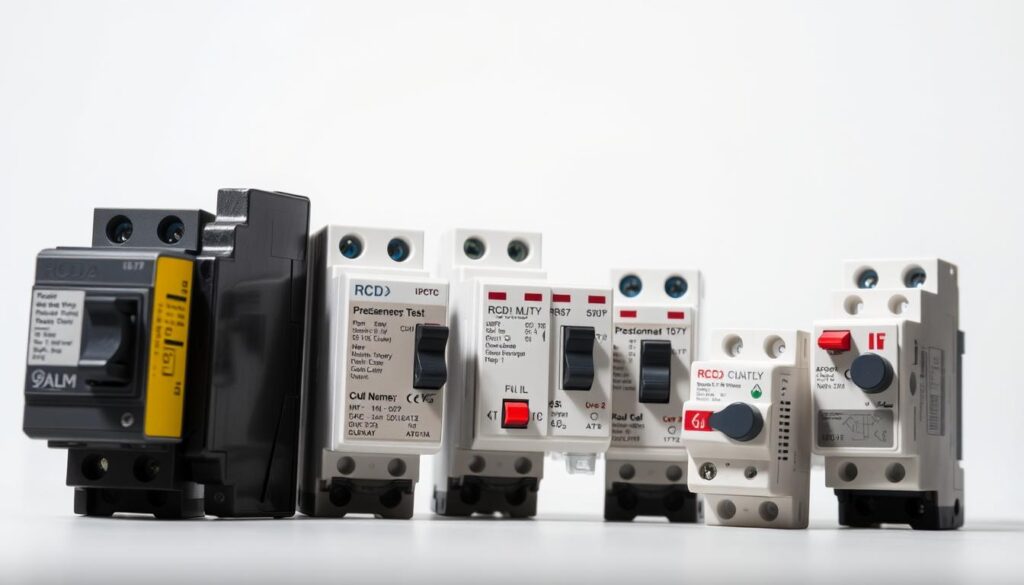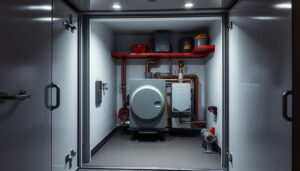Are you aware of the crucial role RCDs play in safeguarding your home or business against electrical shocks and fires? Residual Current Devices, also known as Ground Fault Circuit Interrupters, are a vital safety feature in electrical installations.
These life-saving devices automatically disconnect circuits when they detect dangerous leakage currents, thus preventing shocks, fires, and damage to electrical equipment. Regularly testing RCDs ensures they function correctly, providing protection for you and your property.
Key Takeaways
- Understand the importance of RCDs in preventing electrical shocks and fires.
- Learn how RCDs function to protect electrical installations.
- Discover the different types of RCDs suitable for various applications.
- Follow clear guidance on testing procedures for RCDs.
- Familiarise yourself with the legal requirements for RCD testing in the UK.
Understanding Residual Current Devices (RCDs)
Residual Current Devices (RCDs) are a crucial component in ensuring electrical safety in homes and businesses across the UK. Their primary function is to protect against potentially fatal electric shocks and electrical fires by interrupting the electrical supply when a fault is detected.
What Are RCDs and How Do They Work?
RCDs are sophisticated safety devices designed to monitor the flow of electrical current in a circuit. They work by comparing the current flowing through the live and neutral wires. If there’s an imbalance, indicating a fault or leakage current, the RCD quickly disconnects the circuit, thus preventing electric shocks and potential fires. This swift action is crucial in protecting vulnerable individuals, such as children and the elderly, who are more susceptible to electrical accidents.
The Life-Saving Function of RCDs
The introduction of mandatory RCD protection has significantly reduced electrical fatalities and injuries in the UK. RCDs have saved lives in various scenarios, such as when appliances develop faults or when individuals accidentally come into contact with live parts. According to safety statistics, the presence of RCDs has been instrumental in minimizing the risk of electrical accidents, particularly in environments involving water or outdoor settings. As one expert puts it, “RCDs are the first line of defense against electrical shocks and fires, making them indispensable in modern electrical installations.”
Without RCDs, any electrical installation would be at considerable risk of being overwhelmed by huge currents, potentially leading to intensive damage and complete failure of sensitive electrical equipment. The importance of RCDs cannot be overstated, as they provide a critical layer of protection against electrical hazards.
Why Testing RCDs Regularly Is Essential
Ensuring the proper functioning of RCDs through regular testing is key to safeguarding against electrical hazards. Regular testing of RCDs is a critical aspect of maintaining electrical safety in both domestic and commercial environments.

Preventing Electric Shocks and Fires
One of the primary reasons for testing RCDs regularly is to prevent electric shocks and fires. RCDs are designed to detect and interrupt ground faults, which can cause electrical shocks or initiate fires. By testing RCDs, you can ensure they are functioning correctly and can respond appropriately in the event of a fault.
Legal Requirements and Regulations in the UK
The UK has specific regulations governing RCD testing. The BS7671:2018 wiring regulations require that all electrical installations in commercial properties be inspected and tested every 5 to 10 years. Compliance with these regulations is not only legally required but also crucial for ensuring electrical safety.
| Regulation | Description | Frequency |
|---|---|---|
| BS7671:2018 | Wiring regulations for electrical installations | 5-10 years |
| Electricity at Work Regulations 1989 | Maintenance of electrical systems in workplaces | Regular maintenance |
It is essential to understand the responsibilities of different parties, including homeowners, landlords, and business owners, in ensuring RCDs are properly tested and maintained. Non-compliance with these regulations can result in legal consequences, including implications for insurance coverage in the event of an electrical accident.
Different Types of RCDs in UK Homes and Businesses
Electrical safety in UK homes and businesses is enhanced through the use of different types of RCDs. These devices play a crucial role in preventing electric shocks and fires by detecting and interrupting ground faults.
Fixed RCDs and Consumer Unit Devices
Fixed RCDs are installed within the consumer unit, providing comprehensive protection for the entire electrical circuit or specific circuits. These are typically fitted during initial construction or major electrical renovations.
Socket Outlets with Integrated RCDs
Some socket outlets come with built-in RCD protection, offering an additional layer of safety, particularly in areas prone to moisture like kitchens and bathrooms. These are particularly useful where fixed RCD protection is not available.
Portable RCDs
Portable RCDs are designed to be plugged into any standard socket outlet, providing temporary RCD protection for appliances and tools. They are particularly valuable for use with power tools and garden equipment in locations without fixed RCD protection. It’s crucial to test portable RCDs before each use due to their exposure to physical stress.
When selecting a portable RCD, consider the current rating and intended application. Various types are available, including plug-in adaptors and extension leads with built-in RCD protection. The table below summarises key considerations for choosing the right portable RCD.
| Type of RCD | Application | Current Rating |
|---|---|---|
| Plug-in Adaptor | General Use | 13A |
| Extension Lead | Power Tools, Garden Equipment | 13A, 16A |
Understanding the different types of RCDs and their applications is essential for ensuring electrical safety in UK homes and businesses. Whether fixed, integrated into socket outlets, or used as portable devices, RCDs provide critical protection against electrical hazards.
How to Test Residual Current Devices Regularly
To maintain electrical safety, it’s vital to understand how to test RCDs effectively. Testing RCDs is not just a matter of ensuring compliance with regulations; it’s about safeguarding lives and preventing electrical accidents.
The Test Button Method for Homeowners
For homeowners, testing RCDs can be done using the test button on the device. Pressing this button simulates an fault condition, and if the RCD is functioning correctly, it should trip and disconnect the power supply. This simple test can be performed regularly, ideally every few months, to ensure that your RCD is working as expected.
Important: While the test button method provides a basic indication of RCD functionality, it is not a substitute for professional testing.
Professional Testing Procedures
Professional electricians conduct more comprehensive tests to thoroughly evaluate RCD functionality. These tests include:
- The residual non-operating current test to ensure the RCD doesn’t trip unnecessarily.
- The tripping current and time test to verify that the RCD trips quickly enough when needed.
Specialized equipment, such as RCD testers, is used to measure tripping times in milliseconds. According to British Standards, RCDs must operate within specific parameters to pass inspection.
| RCD Test Type | Description | Expected Outcome |
|---|---|---|
| Residual Non-Operating Current Test | Tests the RCD’s ability to withstand normal operating conditions without tripping. | RCD remains operational without tripping. |
| Tripping Current and Time Test | Verifies that the RCD trips within a specified time frame when a fault is simulated. | RCD trips within the specified time (usually in milliseconds). |
Professional testing also involves documenting the test results, which should include the RCD’s response time and other relevant details. These records should be kept for future reference.
“Regular testing of RCDs is crucial for ensuring electrical safety. It’s not just about compliance; it’s about protecting people and property.”
How Often Should You Test Your RCDs?
To maintain electrical safety and adhere to legal requirements, it’s essential to establish a regular RCD testing schedule for your property. Regular testing ensures that your RCDs are functioning correctly and provides peace of mind, knowing you’re taking proactive steps to prevent electrical shocks and fires.
Recommended Testing Frequency for Different Types
The frequency of RCD testing can vary depending on the type of RCD and the environment in which it’s installed. For most residential properties, testing RCDs monthly is recommended. However, for commercial properties or environments with more demanding electrical usage, more frequent testing may be necessary. It’s also worth noting that regulations and guidelines may specify different testing frequencies for various types of RCDs.
Creating a Testing Schedule for Your Property
To create an effective testing schedule, consider setting reminders or incorporating RCD testing into your property’s maintenance routine. For landlords, this might mean testing RCDs before a new tenant moves in. For homeowners and facility managers, it could involve setting calendar reminders to ensure regular testing isn’t overlooked. By integrating RCD testing into your broader electrical maintenance tasks, you can streamline property management and ensure compliance with relevant regulations.
By making RCD testing a routine part of your property maintenance, you can ensure the electrical safety of your property and its occupants.
Troubleshooting Common RCD Issues
Dealing with a tripped RCD can be challenging, but a systematic approach can help identify and resolve the issue. When an RCD trips, it indicates a potential electrical fault or safety risk, and taking the right steps is crucial to ensure your safety and the integrity of your electrical system.
Why RCDs Trip Unexpectedly
RCDs can trip unexpectedly due to various reasons, including faults in the electrical circuit, moisture ingress, or appliance malfunction. If an RCD trips, you should first switch off all circuits protected by the tripped RCD. The device can then be reset, and you can turn the circuits back on one by one to identify the cause of the trip.
Common causes of RCD tripping include:
- Faulty appliances or wiring
- Moisture or water ingress
- Overloaded circuits
Steps to Take When an RCD Won’t Reset
If an RCD won’t reset, it may indicate a more serious underlying issue. To troubleshoot, isolate the circuits protected by the RCD and check for any visible signs of damage or malfunction. If the issue persists, it’s advisable to consult a professional electrician to diagnose and rectify the problem.
| Step | Action |
|---|---|
| 1 | Switch off all circuits protected by the RCD |
| 2 | Reset the RCD |
| 3 | Turn circuits back on one by one to identify the faulty circuit |

By following these steps and understanding the causes of RCD tripping, you can make sure your electrical system remains safe and functional. If in doubt, always consult a professional to avoid potential risks associated with electrical faults and ensure a reliable power supply.
When to Call a Professional Electrician

Recognising the signs that indicate the need for a professional electrician is vital for your safety. While DIY testing and troubleshooting can be useful, there are specific scenarios that require immediate professional attention.
If your RCDs repeatedly trip, fail to trip when tested, or show signs of physical damage, it’s crucial to call an electrician. These issues can indicate underlying faults in your electrical installation that need to be addressed.
When hiring an electrician for RCD testing and repairs, look for relevant certifications and registration with recognised industry schemes. A professional can perform comprehensive RCD testing beyond the basic test button check, including measurement of actual trip times and currents.
They can also diagnose complex issues such as shared neutrals or earth faults. Ensure the electrician is certified and has great reviews on their professionalism and service.
During a professional RCD inspection, you should receive documentation afterward. Using a registered electrician for any work involving RCDs is crucial due to their safety-critical nature.
Conclusion
RCD testing is not just a regulatory requirement, but a vital safety practice that can save lives. Throughout this article, we’ve explored the critical role Residual Current Devices (RCDs) play in protecting your home and family from electrical shocks and fires. By understanding the different types of RCDs and how to test them regularly, you can significantly enhance your electrical safety.
To ensure your RCDs are functioning correctly, it’s essential to use the test button method regularly and schedule professional testing as recommended. This not only provides a basic check but also ensures compliance with regulatory standards. For more detailed information on RCDs and their importance, you can visit Wave Electrical Solutions, a trusted resource on electrical safety.
Make sure to check that all high-risk circuits are protected and establish a testing schedule to maintain your RCD protection. The potential consequences of neglecting RCD testing, including risk to human life and property damage, far outweigh the small investment of time and money in regular testing. So, test your RCDs regularly and schedule a professional inspection if it’s been more than a year since your last test. Protect your home and property today.



